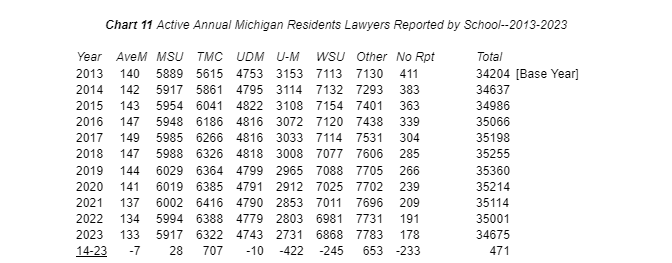Michigan Resident Lawyer Employment Data - Part 7

Michigan Resident Lawyer Employment Data–Part 6 by Don LeDuc, Professor of Law, Cooley Law School
Annually, the State Bar of Michigan collects detailed data regarding its membership, focusing on active Michigan resident lawyers–a focus followed in the seven-part analysis in this series. The data is supplied by and used with the permission of the State Bar. My thanks to Kristen Sewell, the current Research and Analytics Director at the State Bar of Michigan and Anne Vrooman, recently retired from that position, for their work in gathering and providing this information. The data provides an opportunity to examine objectively both the changes from year-to-year and the implications of those changes.
Part 7–Michigan Resident Lawyers by Law School of Graduation. This part displays the legal education background of the active Michigan resident bar membership.

Chart 11 examines the law schools attended by Michigan’s active resident bar membership. This chart shows that membership increased by 471 or 1.4% over the last ten years, an increase of only about 0.14% per year, and that it was relatively flat from 2014 to the present. It shows as well that membership decreased nearly 2% in the four years after the 2019 peak. This chart largely reflects the dynamics of law school admissions in Michigan, the level of academic attrition at the law schools, and their bar examination results, as well as the retirements from practice and deaths of older graduates. It also shows the increasing presence of lawyers who graduated from law schools outside Michigan (by a little over 9%).
Ave Maria was the state’s newest law school, but left Michigan relatively soon. The school's bar membership increased through 2017, but thereafter its declining bar membership numbers reflect the absence of new graduates entering the Michigan bar.
The Detroit College of Law moved to East Lansing and eventually became the law school at Michigan State University. Overall, the school’s bar membership was relatively flat, increasing slightly through 2019, then decreasing slightly thereafter, as it transitioned from a private school to a public, Big Ten school.
Thomas M. Cooley Law School opened and closed three Michigan campuses and opened another in Florida in recent years. Although its bar membership increased 14% by 2021, it has been relatively flat since 2018. TMC’s first graduating class was 44 years ago, so it now introduces far fewer new members, while its aging graduate population experiences increased retirements and other losses.
University of Detroit-Mercy saw relatively flat bar membership. The school’s 2023 bar membership was down only by 10 compared to 2013.
The University of Michigan showed the greatest decline among the law schools, registering a 13% drop in Michigan bar membership. This change largely reflects the significant number of out-of-state admissions at the school and the draw of out-of-state, blue-chip law firms, yielding fewer applicants to the Michigan bar.
Wayne State University bar membership declined in Michigan by over 3% for the period after cresting in 2015. Its subsequent 4% decline likely reflects decreased admissions to the law school, although like the other Michigan Michigan law schools, it had significant numbers of aging and retiring bar members.
Other Schools A largely unrecognized story is presented by out-of-state schools, shown as “Other” on Chart 11. While Michigan has seen steady numbers of bar-examination takers from out of state over recent years, the number of existing out-of-state lawyers admitted to Michigan practice seems to have increased during this period.
This part concludes the look at Michigan’s lawyer profile.

